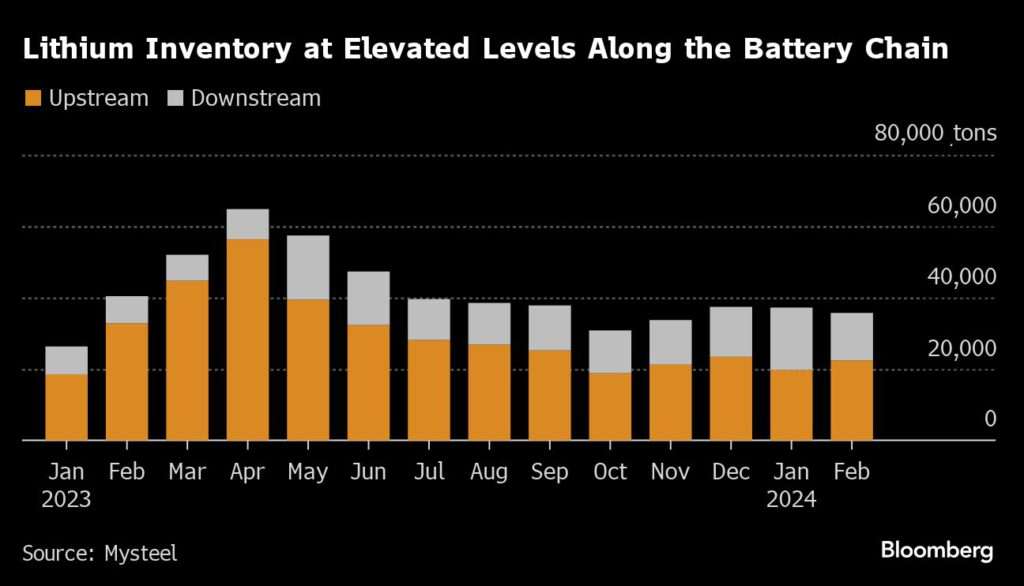The recent stuttering recovery in lithium prices serves as a poignant reminder of the volatile nature of the market, characterized by dramatic rallies followed by breathtaking collapses. Despite the anticipation of a rebound, the industry continues to grapple with surplus stock and the relentless expansion of production capacity.
The surge and subsequent slump in lithium prices over the past few years reflect the evolution of an industry thrust into the global spotlight as a vital component in rechargeable batteries, particularly in the context of the burgeoning electric vehicle (EV) market. However, this rapid growth has also exposed vulnerabilities, including supply chain bottlenecks and fluctuating demand projections.
As prices hit bottom and attempt to recover, miners, refiners, and carmakers are still contending with excess inventory clogging the supply chain. Moreover, despite the downturn’s impact on some projects and mines, major producers remain committed to expanding production, further complicating the prospect of a meaningful price recovery.
The question looming over the industry is whether it is condemned to repeat the boom-and-bust cycle. While analysts and miners anticipate a rebound in prices as EV demand gains momentum, the influx of supply from a more diverse global mining base may temper future price volatility, signaling a potential maturation of the market.
Joe Lowry, founder of advisory firm Global Lithium LLC, expressed concerns about the potential for another drastic price spike, emphasizing the detrimental impact on market stability. A more measured approach to growth and production expansion is necessary to prevent exacerbating volatility and introducing inefficiencies into the system.
The industry’s trajectory hinges on finding a delicate balance between supply and demand dynamics. While a prolonged bear market could strain smaller producers and consolidate power among a few dominant suppliers, excessive volatility undermines long-term planning and investment decisions.
The Sudden Swing to A Global Surplus
For many lithium bulls, the sudden swing to a global surplus has meant coming to terms with the idea that Elon Musk may have been right: there’s a “ridiculous” amount of lithium around the world, and the true supply constraint lies in refining it into battery-grade chemicals. There is also a growing awareness among producers that pricing blowouts increase the likelihood that carmakers seek to avoid lithium altogether in their future batteries.
As EV demand and investment exploded early this decade, the lithium industry initially struggled to keep up. Forecasts of huge shortages drove panic buying among carmakers, which rushed to ink supply deals and even bought directly into mining projects to guarantee access to metal. Prices soared to once-unthinkable levels, prompting warnings that excessive costs would put the very future of the EV industry at risk.

But then the bubble popped. The high prices drew a wave of supply, including from new, small scale producers in places like China and Australia, which operate at high costs but can quickly switch on and off depending on the strength of the market.
Prices collapsed, falling as much as 84% from the peak, as companies that had frantically stocked up were now stuck with massive inventories they are still working through. The result was an effective buyers strike that dragged on for a large part of last year.
The industry is still sitting on a big volume of inventory — of mined ores, lithium chemicals, batteries and electric-vehicles themselves — although a bounce in Chinese prices over the past month signaled that some buyers at least are making a tentative return.
Lithium miners have been hit hard by the plunge — top producer Albemarle Corp. reported a loss in the fourth quarter, while others have also seen their earnings plunge dramatically.
But for some of the key players, the biggest lesson from the recent boom and bust is that the industry needs more, stable lithium supply to ensure a healthy market.
SQM, the second-largest lithium miner, says it’s still plowing ahead with planned expansions and operating at full capacity. In fact, Chile’s finance minister said recently that the country is aiming to double production, arguing that the risk of renewed shortages and price spikes is more dangerous for the industry than a prolonged oversupply.
Lithium’s bright long-term demand outlook and its strategic importance to carmakers and governments could also underpin ongoing funding of new projects even in a depressed price environment.
READ ALSO: Ghana’s Economy Requires Fundamental Resetting- Leading Economist




















